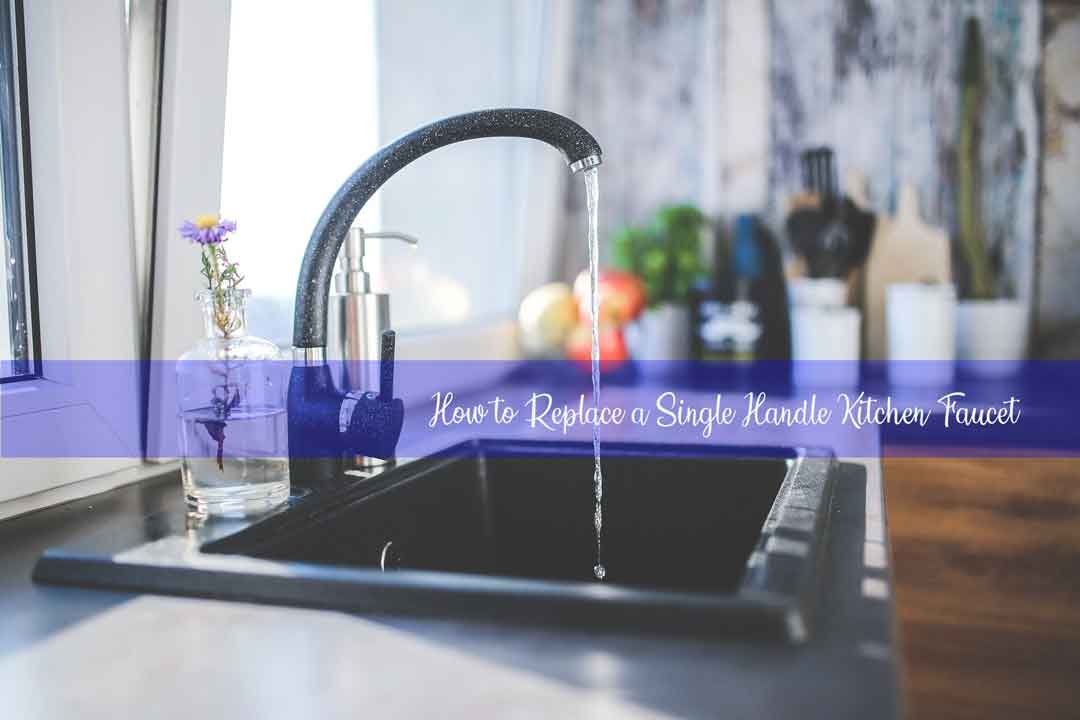by Christopher Jones
We have all dealt with faulty or broken faucets in our lives. These guys give us a run for our time. Whether a kitchen faucet has gone old and rusty or just broken, we should all know how to deal with the situation. So how do we handle it?
If you are having trouble with the replacement of your kitchen faucet, you are not alone. There are lots of people who struggle with this situation. That’s why we are going to guide you through the process of replacing a single handle faucet of your kitchen sink.
The overall summary would be to remove the faulty or old faucet and install the brand new one,but it’s not that simple. Working with modern kitchen faucetscan easily get tricky. So here are the tips and tricks that will help you out in the process.
Contents

Single handle faucets have both its ups and downs. For instance, you can get both the hot and cold water supply with just one handle. On the contrary, if the only handle breaks, both the water supplies will become useless. Here are the steps for the replacement of the faucet.
This is practically the first step in the process. Some would say this is even the most difficult step. If you have an older model, things can get very tricky;especially, if you are working by yourself and not calling a plumber.
On the other hand, if you happen to have an eco-friendly dishwasher, you might face even more difficulties while removal. Thus, if your sponge holder gets in the way of your faucet, you might need to unscrew it too.
In this regard, first of all, make sure you have the new model available close to you. You need to duck under the sink and check for the valves that shut the water supply off. Usually, two valves belong to hot and cold water supplies. It will be required for you toshut both of them off.
Now, this part can get hard if you haven’t been fiddling around with the valves too often. The valves might get frozen or stuck. You might need to pull out a wrench for this one. If even that doesn’t work, turn off the main water supply of the house.
Likewise, if your faucet is broken, you will automatically know if this worked or not. If you are replacing a working faucet, turn it on to check if the water supply stopped or not. Make sure you have a bucket close to you. You will need to place the bucket under the sink so that the residual water is caught in it.
Next up, you will need to disconnect the water pipes from the valves. This part also comes with difficulty. The pipes might start to turn along with the screw. So you need to hold it in place while unscrewing. If it still doesn’t work, you probably need to change the pipes as they are probably worn out.
Look up,you will notice the nuts by which the faucet is attached to your sink. This process varies a little, depending on the type of your faucet. Some faucets are attached to the side of the sink. This makes it incredibly hard to reach and unscrew it from that tight place.
However, if you have done this before, you probably know that a basin wrench will come in handy in this sort of situation. But chances are that this is your first time. So you would probably want to have one of those around. The tool makes it super easy to reach that cramped space and remove the nuts.
You need to turn counterclockwise, or simply put, lefty loosey. If your faucet is years old, you might need to get things oily. Grab some penetrating oil and then turn. That should do it! You will feel the faucet gradually getting looser.
Some people face the problem where the faucet is stuck to the sink. This happens due to the seal that was applied during the installation to prevent any sort of leakage. Wiggle it a little bit and you will get it loose in a couple of minutes.
Finally, after removing the faucet, you need to clean the surface up a little bit. Any sort of residue of the seal or putty will be detrimental for the installation of the new faucet.
Time to bring out your brand new faucet from its box, if you haven’t done that already. Put the brand new faucet into the hole from the top of the sink. If you have reach-issues, try calling for a second pair of hands to hold it for you.
Once you have the faucet in place, use the provided nuts to wrench it in from the bottom of the sink.
Remember those pipes for the hot and cold waters? Bring them back in. Attach them to the faucet from under the sink. If you needed a new pair, bring the new ones in.
Now reconnect these pipes to the two valves you used to shut off the water supply. Wrench it in tightly. Usually, there will be an instruction manual in the box of the new faucet. You can refer to it when needed.
Time to check whether your steps were correct or not. Turn the shutoff valves or the main water supply (depending on which step you followed). Now turn on the faucet to see if the water is coming out. Give it a second.
You will most probably observe that the water is coming out quite fast. Make sure to check for both cold and hot water. Sometimes the pressure of the two might vary. Now turn the water back off.
Since you haven’t used any seal or putty, there is a chance you will see leakage even if you tightened all the connections with all the strength in the world. Use a quality seal where needed. The recommended spots are around the faucet base, around the nuts of the faucet, and the shut-off valves. Now turn the water on again, check again, and repeat till there are no more leaks.
Replacing a water faucet in your sink may be a challenging task,especially if it’s your first time doing so. Nevertheless, if you follow the steps properly and don’t manage to accidentally break a thing or two, you will be good to go. And again, do check for leaks! So go on, give it a try!
 |
 |
 |
 |
 |
 |
 |
 |

About Christopher Jones
Chris is a true globetrotter. He has been to many destinations and tried different types of food from all over the world, yet he still loves finding new places and tasting their specialties. Chris has always had an entrepreneurial spirit and so he decided to go back to school at age 24 for his MBA at University of San Francisco so that he could have a better understanding of business strategy in order to start his own company. His favorite motto is “how can one live well, travel well, and work well without having good food every time?”
Check for FREE Gifts. Or get our Free Cookbooks right now.
Disable the Ad Block to reveal all the recipes. Once done that, click on any button below
 |
 |
 |
 |